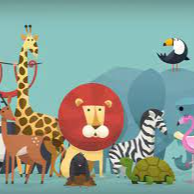Awesome Animal Facts

About
Lovely Animals!
Cuba
Description
Captivating Animal Facts
10. Frogs have ear drums outwardly of their heads. While frogs don't have an outside ear as people do, they have an inward ear, center ear, and an external ear drum or tympanum.
10 Amazing Google Earth Birds-Eye Views
9. Ocean otters generally float on their backs when they eat. These marine warm blooded creatures feast on creatures including mussels, ocean imps, mollusks, and snails, all while drifting on their backs. Their very thick fur safeguards them from the virus waters as they eat.
8. Polar bears look white, yet they really have dark skin. Dissimilar to different bears, their fur is straightforward and mirrors apparent light. This permits polar bears, which live in the cold tundra, to mix in with their snow covered climate.
7. Winds generally keep their eyes open, in any event, when they are snoozing. Snakes can't shut their eyes since they don't have eyelids. They truly do have eye scales which cover their eyes and shed when the snake sheds its skin.
6. Crickets have ears on their front legs. Found just beneath the knees, their ears are among the littlest in the animals of the world collectively. Notwithstanding crickets, grasshoppers and beetles likewise have ears on their legs.
5. Aardvarks can hear and smell termites and insects. An aardvark utilizes its long tongue to venture profound into termite and subterranean insect hills. These creatures can eat a huge number of bugs in a solitary evening.
4. Cobras can kill with a chomp when they are conceived. Child cobra toxin is similarly pretty much as powerful as a grown-up cobra's toxin. Their nibble is hazardous on the grounds that cobras can infuse a lot of toxin in a solitary chomp. Cobra toxin contains a neurotoxin that influences the focal sensory system and can prompt loss of motion, respiratory framework disappointment, and demise.
3. Flamingos have knees that can twist in reverse. Well truly, what resembles knees are actually its lower legs and heels. A flamingo's knees are found nearer to its body and concealed under its plumes.
2. The gun shrimp gets its prey by astonishing it with a noisy banging commotion made with its hooks. The sound is clearly to such an extent that it shocks or even kills their prey. The sound made by gun shrimp paws can be pretty much as uproarious as 210 decibels, which is stronger than a discharge.
1. A few types of Australian Flower Spiders eat their mom when food becomes restricted. The mother insect penances herself by empowering her young children to go after her, break down her internal parts, and feed on her body. Savagery is likewise seen in other bug species and most frequently seen comparable to sexual experiences.
About
Lovely Animals!
Cuba
Description
Captivating Animal Facts
10. Frogs have ear drums outwardly of their heads. While frogs don't have an outside ear as people do, they have an inward ear, center ear, and an external ear drum or tympanum.
10 Amazing Google Earth Birds-Eye Views
9. Ocean otters generally float on their backs when they eat. These marine warm blooded creatures feast on creatures including mussels, ocean imps, mollusks, and snails, all while drifting on their backs. Their very thick fur safeguards them from the virus waters as they eat.
8. Polar bears look white, yet they really have dark skin. Dissimilar to different bears, their fur is straightforward and mirrors apparent light. This permits polar bears, which live in the cold tundra, to mix in with their snow covered climate.
7. Winds generally keep their eyes open, in any event, when they are snoozing. Snakes can't shut their eyes since they don't have eyelids. They truly do have eye scales which cover their eyes and shed when the snake sheds its skin.
6. Crickets have ears on their front legs. Found just beneath the knees, their ears are among the littlest in the animals of the world collectively. Notwithstanding crickets, grasshoppers and beetles likewise have ears on their legs.
5. Aardvarks can hear and smell termites and insects. An aardvark utilizes its long tongue to venture profound into termite and subterranean insect hills. These creatures can eat a huge number of bugs in a solitary evening.
4. Cobras can kill with a chomp when they are conceived. Child cobra toxin is similarly pretty much as powerful as a grown-up cobra's toxin. Their nibble is hazardous on the grounds that cobras can infuse a lot of toxin in a solitary chomp. Cobra toxin contains a neurotoxin that influences the focal sensory system and can prompt loss of motion, respiratory framework disappointment, and demise.
3. Flamingos have knees that can twist in reverse. Well truly, what resembles knees are actually its lower legs and heels. A flamingo's knees are found nearer to its body and concealed under its plumes.
2. The gun shrimp gets its prey by astonishing it with a noisy banging commotion made with its hooks. The sound is clearly to such an extent that it shocks or even kills their prey. The sound made by gun shrimp paws can be pretty much as uproarious as 210 decibels, which is stronger than a discharge.
1. A few types of Australian Flower Spiders eat their mom when food becomes restricted. The mother insect penances herself by empowering her young children to go after her, break down her internal parts, and feed on her body. Savagery is likewise seen in other bug species and most frequently seen comparable to sexual experiences.
